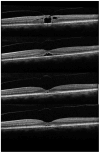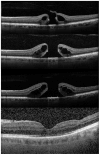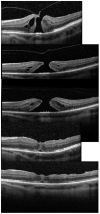Ocriplasmin for treatment of stage 2 macular holes: early clinical results
- PMID: 25037011
- PMCID: PMC4342757
- DOI: 10.3928/23258160-20140709-05
Ocriplasmin for treatment of stage 2 macular holes: early clinical results
Abstract
Background and objective: To review clinical and structural outcomes of ocriplasmin for treatment of stage 2 macular holes.
Patients and methods: A retrospective review of the first patients with stage 2 macular holes to be treated with ocriplasmin at Massachusetts Eye and Ear Infirmary. All patients were imaged with spectral-domain optical coherence tomography (SD-OCT).
Results: Eight patients with stage 2 macular holes received a single injection of 125 μg of ocriplasmin. One patient (12.5%) demonstrated macular hole closure. The posterior hyaloid separated from the macula in six eyes (75%). All seven holes that remained open showed enlargement in hole diameters (narrowest, apical, and basal) at 1 week and 1 month. All seven were successfully closed with surgery. Ellipsoid zone disruptions were observed by OCT in four eyes (50%) and persisted throughout follow-up (more than 6 months on average).
Conclusion: In early clinical results, the authors found a lower macular hole closure rate with ocriplasmin than previously reported. Enlargement was observed in all holes that failed to close with ocriplasmin. The authors found ellipsoid zone disruptions that persisted through 6 months of follow-up after ocriplasmin injection. Further work is needed to investigate the cause for these ellipsoid zone changes.
Copyright 2014, SLACK Incorporated.
Conflict of interest statement
The authors have no conflicts of interest.
Figures




References
-
- Kelly NE, Wendel RT. Vitreous surgery for idiopathic macular holes. Results of a pilot study. Arch Ophthalmol. 1991;109:654–659. - PubMed
-
- Gass J. Stereoscopic atlas of macular diseases: diagnosis and treatment. 1987
-
- Rhéaume MA, Vavvas D. Pharmacologic vitreolysis. Semin Ophthalmol. 2010;25:295–302. - PubMed
-
- Verstraeten TC, Chapman C, Hartzer M. Pharmacologic induction of posterior vitreous detachment in the rabbit. Archives of …. 1993 - PubMed
-
- Takano A, et al. Intravitreal plasmin injection activates endogenous matrix metalloproteinase-2 in rabbit and human vitreous. Am J Ophthalmol. 2005;140:654–660. - PubMed
MeSH terms
Substances
Grants and funding
LinkOut - more resources
Full Text Sources
Other Literature Sources

